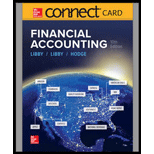
1)
Complete the comparing across time analysis of Company S’s comparative financial statement.
1)
Explanation of Solution
Comparison of across time analysis of financial statements: In this method of analysis of financial statements, the amount of each current year item of the financial statement is compared with the previous year amount. The amount of each item increased or decreased in the current financial statements, and its respective percentage can be computed by taking the earlier statement as the base.
Comparing across time analysis of financial statements of Corporation S:
| Corporation S | ||||
| Comparative Income Statement | ||||
| Year Ended Year 2 | ||||
| Particulars | Year 2 | Year 1 | Increase (decrease) | |
| Amount (A) | Amount (B) |
Amount (C) |
Percent (D) | |
| Sales revenue | $ 453,000 | $ 447,000 | $6,000 | 1.34% |
| Cost of goods sold | ($ 250,000) | ($ 241,000) | ($9,000) | 3.73% |
| Gross profit | $ 203,000 | $ 206,000 | ($3,000) | -1.46% |
| Operating expenses (Including interest on bonds) | ($ 167,000) | ($ 168,000) | ($1,000) | -0.60% |
| Pre-tax Income | $ 36,000 | $ 38,000 | ($2,000) | -5.26% |
| Income tax expense | ($ 10,800) | ($ 11,400) | ($600) | -5.26% |
| Net income | $ 25,200 | $ 26,600 | ($1,400) | -5.26% |
Table (1)
| Corporation S | ||||
| Comparative Balance Sheet | ||||
| As on Year 2 | ||||
| Particulars | Year 2 | Year 1 | Increase (decrease) | |
| Amount (A) | Amount (B) |
Amount (C) |
Percent (D) | |
| Cash | $ 6,800 | $ 3,900 | $2,900 | 74.36% |
| Accounts receivable (net) | $ 42,000 | $ 29,000 | $13,000 | 44.83% |
| Merchandise Inventory | $ 25,000 | $ 18,000 | $7,000 | 38.89% |
| Prepaid expenses | $ 200 | $ 100 | $100 | 100.00% |
| Property and equipment (net) | $ 130,000 | $ 120,000 | $10,000 | 8.33% |
| Total assets | $ 204,000 | $ 171,000 | $33,000 | 19.30% |
| Accounts payable | $ 17,000 | $ 18,000 | ($1,000) | -5.56% |
| Income taxes payable | $ 1,000 | $ 1,000 | $0 | 0.00% |
| Bonds payable (Interest rate: 10%) | $ 70,000 | $ 50,000 | $20,000 | 40.00% |
| Common stock($10 par value) | $ 100,000 | $ 100,000 | $0 | 0.00% |
| $ 16,000 | $ 2,000 | $14,000 | 700.00% | |
| Total liabilities and equity | $ 204,000 | $ 171,000 | $33,000 | 19.30% |
Table (2)
2)
Determine the amount of
2)
Explanation of Solution
Current ratio: Current ratio is used to determine the relationship between current assets and current liabilities. The ideal current ratio is 2:1.
Current ratio for Year 2:
Current ratio for Year 1:
The current ratio is increased by 1.43
Note: Current assets include Cash, Accounts receivable (net), Merchandise inventory and prepaid expenses. Current liabilities include Accounts payable and Income taxes payable.
Want to see more full solutions like this?
Chapter 13 Solutions
Connect Access Card For Financial Accounting
- I need help solving this general accounting question with the proper methodology.arrow_forwardThe merchandise inventory of sunny retailer was destroyed by fire on November 20.arrow_forwardHow does operational synchronization enhance period matching? a. Calendar periods work perfectly b. Synchronization wastes effort c. Business cycle alignment improves temporal relationships d. Standard periods fit all MCQarrow_forward

 AccountingAccountingISBN:9781337272094Author:WARREN, Carl S., Reeve, James M., Duchac, Jonathan E.Publisher:Cengage Learning,
AccountingAccountingISBN:9781337272094Author:WARREN, Carl S., Reeve, James M., Duchac, Jonathan E.Publisher:Cengage Learning, Accounting Information SystemsAccountingISBN:9781337619202Author:Hall, James A.Publisher:Cengage Learning,
Accounting Information SystemsAccountingISBN:9781337619202Author:Hall, James A.Publisher:Cengage Learning, Horngren's Cost Accounting: A Managerial Emphasis...AccountingISBN:9780134475585Author:Srikant M. Datar, Madhav V. RajanPublisher:PEARSON
Horngren's Cost Accounting: A Managerial Emphasis...AccountingISBN:9780134475585Author:Srikant M. Datar, Madhav V. RajanPublisher:PEARSON Intermediate AccountingAccountingISBN:9781259722660Author:J. David Spiceland, Mark W. Nelson, Wayne M ThomasPublisher:McGraw-Hill Education
Intermediate AccountingAccountingISBN:9781259722660Author:J. David Spiceland, Mark W. Nelson, Wayne M ThomasPublisher:McGraw-Hill Education Financial and Managerial AccountingAccountingISBN:9781259726705Author:John J Wild, Ken W. Shaw, Barbara Chiappetta Fundamental Accounting PrinciplesPublisher:McGraw-Hill Education
Financial and Managerial AccountingAccountingISBN:9781259726705Author:John J Wild, Ken W. Shaw, Barbara Chiappetta Fundamental Accounting PrinciplesPublisher:McGraw-Hill Education





